Tilman interview: Color as material (2013)
artdesigncafé - art | 1 February 2014
This article-interview was previously published in Sculpture magazine, 32(4), pp. 26-31 and made the cover in May 2013.
-
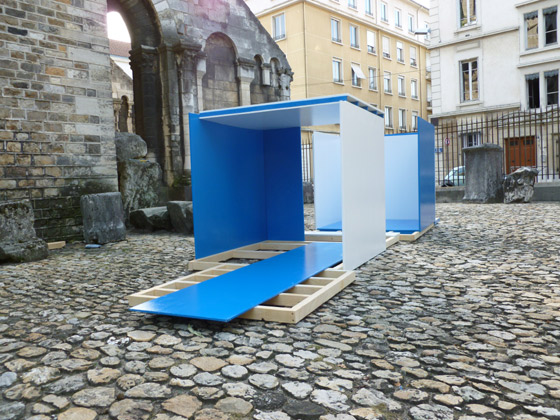
Tilman. Untitled / U.O.S. # 5, (2011). Lacquer on MDF-board & wood; ca. 320 x 120 x 120. Installation view: exhibited in group exhibition Columna 1 / Lyon Biennial 2011 Satellite (2011) at Musée Lapidaire, Vienne, France.
Tilman interview: Color as material
Tilman is definitely an artist’s artist. I first encountered his two-dimensional, non-objective work about 10 years ago while staying at the Center for Contemporary Non-Objective Art (CCNOA) in Brussels, where he was the artistic director. I grew quite fond of his “Tilman sandwiches”— layered horizontal stacks of painted materials that began his shift toward objects. Since then, he has moved into three-dimensional constructions, a direction that has widened his pursuit of color as a material and carrier of light by applying it across various structural forms.
-
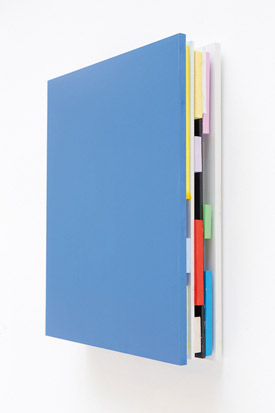
Tilman. 30.10 / Stack, (2010). Lacquer on MDF-board; 42 x 32 x 9.5 cm. Installation view: exhibited in solo exhibition Painted Obje(c)ts Ambigus (2011) at Linard*Langsdorff, Paris, France.
In the 27 years since Tilman graduated from art school in Munich, he has exhibited at art spaces across Europe, the United States, Japan, New Zealand, and Australia. He has had solo shows at the Kunstnernes Hus in Oslo, Dům Umění České Budějovice / House of Art in the Czech Republic, and Galerie Linard* Langsdorff in Paris. Recently he has participated in group exhibitions at MoMA PS1 and the Columna 1 / Lyon Biennial 2011 Satellite Program, and he’s shown numerous works at CCNOA. Tilman, who is very well networked in the international non-objective art scene, has played a key role in the exhibition and dissemination of such work.
The following are excerpts of my interview of Tilman.
R.J. Preece: After 16 years of pursuing non-objective painting, why did you expand your practice to include three-dimensional work?
Tilman: From 1982, when I entered the Akademie der Bildenden Künste München, I focused exclusively on painting. Then, in the mid-’90s, I started to realize that I could not manifest what I was looking for— namely, to create a platform to expose the essential qualities of light and the interpretation of light in our visual system— within the common means of painting. I arrived at the understanding that one cannot paint light itself, only an image of it. I had to find another form that would allow me to work with light and its natural properties.
-
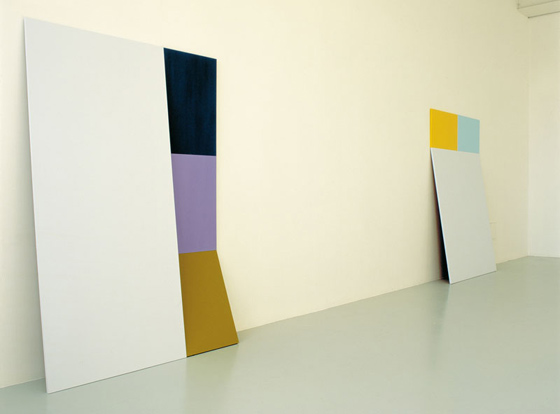
Tilman. Left: 54.00 / Transform, (2000). Lacquer on MDF-board; 180 x 120 cm, in multiple parts. Right: 53.00 / Transform, (2000). Lacquer on MDF-board; 180 x 120 cm, multiple parts. Installation view: exhibited in solo exhibition Transforms & Constellations (2000) at CCNOA, Brussels, Belgium.
During the installation of one of my first exhibitions in Europe, at CCNOA (2000), I accidentally discovered a solution to my problems. A two-part work, Transforms (54.00/53.00), was leaning against the wall, ready to be hung. I saw the light floating over the different colored planes, changing the tonalities. The movement of light over time brought the whole assemblage to life, establishing a dialogue between the work and the luminous qualities of its surrounding space. The colored planes started to breathe and to engage in the realm of light.
Preece: Could you give some details about your art school training? Was it in the Bauhaus model, with a year of projects devoted to specific visual elements and principles of design? How does your innovative work fit into the notion of concept-based work?
Tilman: My works are usually inspired by observations and visual experiences that catch my eye and trigger associations. My eyes find what I am looking for and initiate the creative process. In the best cases, they find what I am not looking for.
My art school training was actually very limited. My teacher, Günter Fruhtrunk, died after my third semester and, from then on, I was on my own. I remember that we barely talked about art at our weekly meetings; instead, we discussed philosophy, psychology, politics, perception, and phenomenology. He gave me the confidence and perspective to pursue my decision to be an artist. The Bauhaus model wasn’t part of my training at the Munich Academy, but thanks to my parents, a lot of ideas inspired by Bauhaus methods shaped my early upbringing and education.
Preece: How do you go about selecting your colors and contrasts?
Tilman: Color for me is a material— it performs as a carrier of light, exposing its manifold and subtle qualities.My selection isn’t based on a particular kind of color theory. I choose colors intuitively, according to their individual properties: I evaluate their volume and possibility for absorption or reflection, their luminous qualities and how they will interact within a projected work of art. I am looking for the interaction of primary and secondary colors and subtle, sometimes barely perceptible differences in color shades.
-
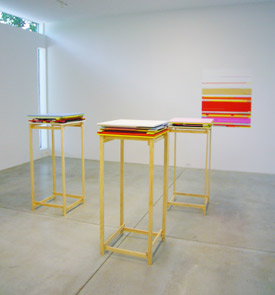
Tilman. Foreground: Stack 1 - 3, (2006). Lacquer on MDF-board, Plexiglas; each 60 x 60 x 12 cm; Background: Untitled, (2007), adhesive foils on wall; dimensions variable. Installation view: exhibited in two-person exhibition (2007) at Sonja Roesch Gallery, Houston, Texas.
Preece: How did you develop the horizontal stacks that were exhibited at CCNOA and the Sonja Roesch Gallery in Houston? Am I the only person who calls them “Tilman sandwiches”?
Tilman: The idea to present the works horizontally developed during the fabrication process. More like painted objects than paintings, these works challenged me to find another way to present them rather than simply mount them on the wall. The horizontal presentation offered a different perception of the painted surfaces, the negative and positive spaces, the interaction of light and shadow, and the overall appearance of the object. The notion of comparing the objects to sandwiches is humorous, and I’m afraid you aren’t the only one who has done so.
Preece: You have mentioned your interest in “light,” but could you explain this in more detail? Do you mean the actual light in a space, whether natural or artificial, and in relation to the walls and the color selection of the works?
-
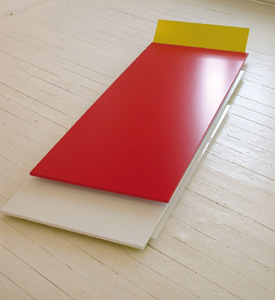
Tilman. Untitled / For Marthe, (2005). Lacquer on MDF-board, Plexiglas; 251 x 120 x 20 cm. Installation view: exhibited in group exhibition Minimal Pop (2005) at Galerie Les Filles du Calvaire, Brussels, Belgium.
Tilman: I see colors as paint, as materials. Colors are vehicles to transport light— not only the idea of light, but also its physical quality, whether it be natural or artificial. In some of my earlier, more two-dimensional works, I placed two separate planes with different tonalities on top of each other, then added painted MDF in a different color at an angle at the top, bottom, or side. This creates a tilted colored plane, which acts as a reflector. It diffuses the light falling on the adjacent plane, making the physical qualities visible. Untitled / For Marthe (2005), which is placed on the floor, exposes the object to natural light in a different fashion.
Preece: Are all of your colors customized? Do you create them yourself?
Tilman: Back when I used canvas and oil paint, I mixed the colors myself using dry pigments. Later, I began to work with acrylic paints and various lacquers, which came pre-mixed off the shelf. Now I use enamel, which I can have custom-mixed at the store. Sometimes I bring color samples and have them matched. I might choose brands that offer a higher quality in terms of saturation or finish, but I always buy them straight from the shop and use them straight out of the can, with no further manipulation.
-
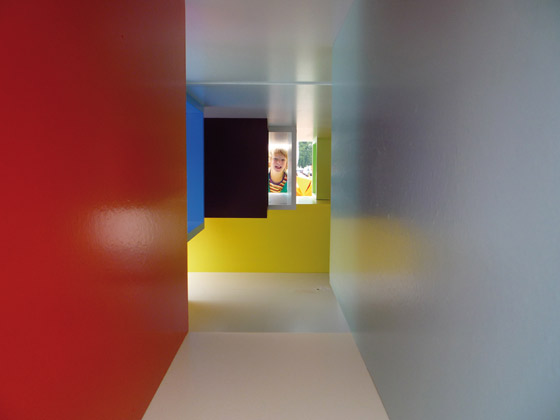
Tilman. House of Colors, (2008). Interior view. Lacquer on MDF-board; 360 x 210 x 136 cm, in 38-parts.
Preece: How did you go about making House of Colors (2008)?
-
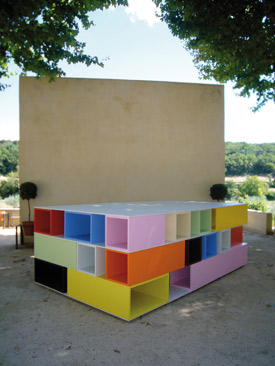
Tilman. House of colors, (2008). Lacquer on MDF-board; 360 x 210 x 136 cm, in 38-parts. Installation view: exhibited in the sculpture garden (2011) of Eric Linard Galerie, La Garde Adhémar, France.
Tilman: When I started making the painted stacks around 2005, I became interested in their structural character and how they functioned as architectural objects. I wanted to intensify the play of light and shadow, so I began to create new objects. The use of materials other than MDF allowed me to expand on the idea to open and close spaces within the objects and to explore a different spatiality. These pieces came to resemble miniature architectures, so I titled them House of Colors. In 2008, I was invited to participate in the Antwerp Sculpture exhibition organized by MuHKA and the Middelheim Museum, which gave me my first opportunity to exhibit House of Colors and produce it at a larger scale.
Preece: Why do you work so much with MDF?
Tilman: I like the quality of its surface— it is absolutely smooth, and I cannot attach any associations to it. I also like the material’s contradictions: on one hand, it radiates an apparent solidity because of its weight and volume; on the other, it has a certain rawness and fragility. On the most practical level, I like that it is available around the world, which is very important to my work process. I create objects and site-specific pieces in locations far from my studio. Wherever I’ve realized projects over the few last years— Europe, the U.S., Australia, or Japan— I’ve never had a problem finding MDF.
Preece: What other materials do you like? Any that you really don’t like?
Tilman: In addition to MDF, I work with colored sheets of foam, plastic, glass, and aluminum. Because I am not interested in applying the paints in a “painterly” way, I usually choose materials that provide a perfectly smooth surface. I pay close attention to their inherent qualities— volume, weight, and appearance. Often, I will use multiple materials within one piece, which adds to the overall appearance and aura of the object— the work becomes more tactile due to the different qualities of the materials, their variations in hue, density, volume, and tonality. I always select the materials according to the requirements of the individual work. In House of Colors (2006) and in my most recent series, “Flats” (2010/12), I used aluminum panels and profiles (squared tubing). The available sizes and shapes allow the light to pass through, creating shadows and color interaction.
Preece: There’s one thing that confuses me. You create monochrome expanses, yet you insist on hand-painting them. You could outsource the labor, even use materials providing a more industrial finish, but you don’t. Is this Tilman the Romantic Painter, or is there another reason?
Tilman: I don’t think that it is a question of being “Romantic.” I could never have my works fabricated— even though it’s a common practice, especially in the realm of Minimalism. I need the mental and physical engagement with the materials and the space in which I am working, whether it be the studio, a gallery space, or when I work in situ. This engagement stimulates and emancipates my perceptions and thoughts about making art or simply being of this world. My entire body and mind become the work, engaged in an essential experience. Only when this genuine exchange takes place can I lend my associations to the work-in-progress.
RP to replace image below.
-
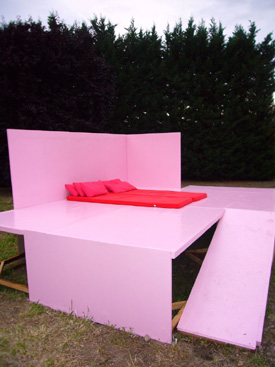
Tilman. Untitled / Temptation Island (2007). Lacquer on MDF-board, tape recorder, mattresses, 440 cm x 240 cm x 480 cm. Accompanying sound provided by Wolfgang Glum, Berlin. Installation view: exhibited in group exhibition Pas de soucis (2007) at Non-objectif Sud, Tulette, France.
Preece: Could you explain Untitled / Temptation Island (2007)? It looks like a non-objective love nest.
Tilman: Basically, Untitled / Temptation Island is an “unfolded” architectural space that can function in numerous ways— it invites the viewer to participate and define the space for his or her own self, whether as a meeting ground, a “room” for contemplation, or even a place to practice yoga. The object is meant to provoke thought about privacy and public exposure, or differing qualities of interior or exterior space.
Preece: In Brussels, you always seem to be surrounded by art books and magazines. Whose work do you really appreciate, and why?
Tilman: Beautiful publications are my vice, especially when it comes to art books. My library functions as an archive of related thoughts— a voyage of shared interests. As for the artists whom I appreciate, that’s hard to say. I like works that trigger my perception and understanding of the world. For example, many years ago, I learned about the work of the late Brazilian artist Hélio Oiticica. His utopian outlook on the world, his innovative use of color and light, his engagement with environmental art, and his writings are of great interest for me in my own understanding of artistic production.
Preece: All of the furnishings in your Brussels flat, except for some chairs, a mattress, and a couch, are made of MDF, like your works. Do you see that space almost as an art installation?
Tilman: No, the apartment is strictly my home. Usually I build the furniture myself; I don’t think I have ever purchased a piece of furniture in my life. Sure, there are great designs out there, but I love to customize objects for myself— they may not always be comfortable, but they are built to my own volume, necessity, and spirit.
Preece: Looking back at the key works in your move to three dimensions, did you know that they would be important when you made them? How do you feel about them now?
-
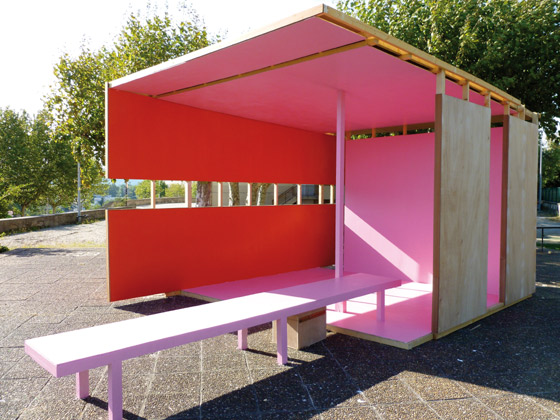
Tilman. Artitecture 1 / Cabane Communal, (2011). Lacquer on wood, ca. 500 x 420 x 300 cm. Installation view: exhibited in group exhibition Columna 1 / Lyon Biennial 2011 Satellite (2011) in the center of Chasse-sur-Rhone, France.
Tilman: I don’t think about the importance of a piece while I am making it. It was only after I created Transforms that I realized it was a breakthrough. I had similar experiences with F 218 B-BXL (2003), my first large spatial installation in Brussels, and House of Color (2008), which gave me the confidence to create large-scale, outdoor pieces like Artitecture 1 / Cabane Communal (2011) in Chasse-sur-Rhone and Artitecture 2 / Passage de Lumière (2012) in Braine-l’Alleud.
-
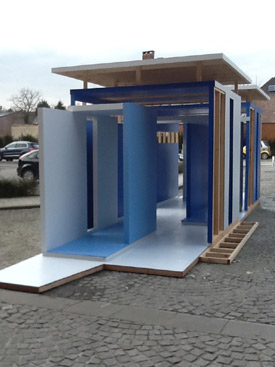
Tilman. Artitecture 2 / Passage de Lumière (2012). Lacquer on MDF-board & wood; 1020 x 275 x 250 cm. Installation view: exhibited in group exhibition Colorific (2011-2012) at École des Arts de Braine-l’Alleud, Braine-l’Alleud, Belgium.
Preece: If you could choose just one art-making or exhibiting experience to relive, which one would that be?
Tilman: I would love to relive them all again— the struggles and innovations are the essence of being an artist. There is one experience in particular, however, that I should mention. In 2006, I had my first large-scale presentation at the Kunstnernes Hus in Oslo; the show was called “Tilman: Look Awry.” I was given complete freedom to do whatever I wanted. For one part of the exhibition, I created a series of wall works and floor objects like Untitled / Val Duchesse (2006). For the second part, I created the site-specific installation N 802-B. It was a huge project, measuring about 20 meters in length, 10 meters wide, and 4.5 meters high, and it incorporated video, as well as sound produced by the Belgian composer Aernoudt Jacobs. Viewers entered the installation and encountered the sensory phenomena of shifting light and modulating sounds. I took huge risks. It was an enormous challenge involving precision and planning, but in the end, it was extremely satisfying.
-
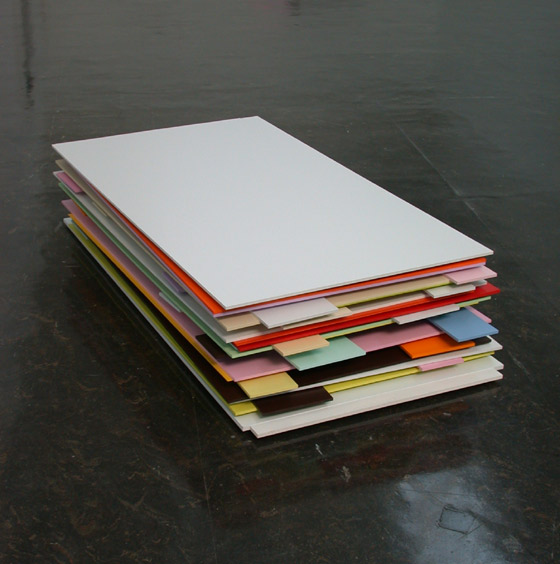
Tilman. Untitled / Val Duchesse (2006). Lacquer on MDF-board; 251 x 132 x 52.5 cm, in multiple parts. Installation view: exhibited in solo exhibition Tilman - Look Awry (2006) at Kunstnernes Hus, Oslo, Norway.